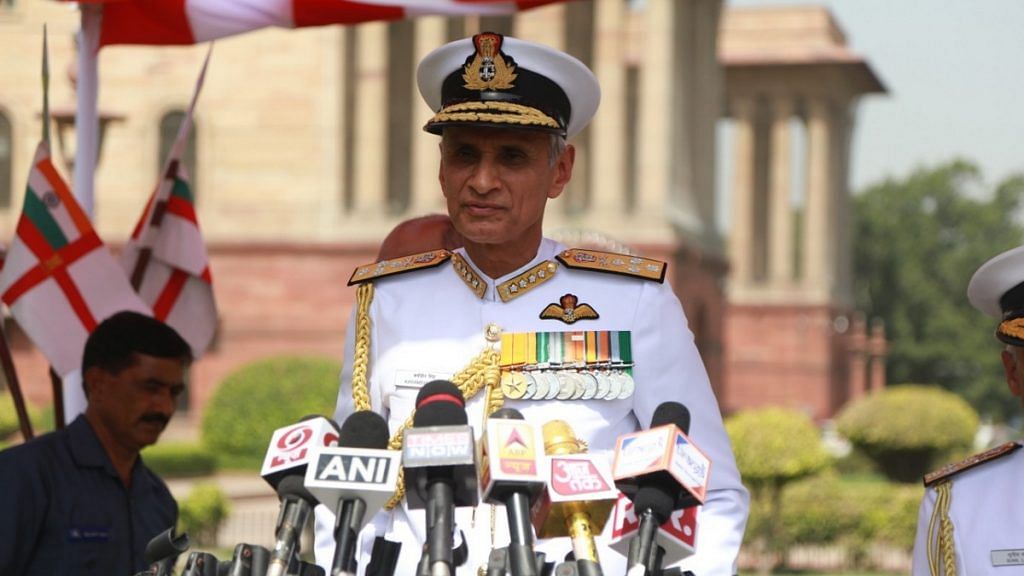New Delhi: Navy Chief Admiral Karambir Singh said Thursday the Navy needed to carefully watch China’s global ambitions and see how it could respond within its existing budget and other constraints.
Singh’s remarks come a day after China released its defence white paper, which mentioned Chinese military’s increased global focus for which its People’s Liberation Army (PLA) Navy is critical. China has been focusing on its Navy and is in the process of constructing warships, including aircraft carriers and submarines, on war footing.
Singh was speaking to the media on the sidelines of a seminar on ‘Nation Building through Shipbuilding’, organised by the Federation of Indian Chambers of Commerce & Industry in Delhi.
“It is not just the Chinese white paper, it has been said in the past also. Lot of resources has been shifted from other arms to the PLA Navy obviously in line with their intention to become a global power. We have to watch that and see how we can respond within our budget and constraints that we have,” he said.
“We require long-term fiscal support to build the Navy and that is the only way we can plan,” he said.
‘Shipbuilding perceived as a drain on economy’
Addressing the seminar, Singh highlighted the Navy’s current budgetary constraints and said shipbuilding would contribute immensely to the government’s plans of making India a $5-trillion economy by 2024.
“The fiscal environment calls for prudence and optimisation of every rupee spent,” he said, listing time and cost overruns as the challenges before them.
Singh said naval shipbuilding being a capital-intensive activity is perceived as a drain on the economy though it contributes handsomely to the economic growth and nation-building in a “plough back effect”.
Also read: This secret facility is helping China’s navy become a submarine superpower
Singh said more than 60 per cent of the naval budget is dedicated to capital expenditure and nearly 70 per cent of this capital budget is spent on indigenous sourcing, amounting to Rs 66,000 crore in the last five years.
“Since the launch of ‘Make in India’ in 2014, 80 per cent of the AoNs (Acceptance of Necessity) on cost basis have been awarded to Indian vendors. Of the total 51 ships and submarines on order at various shipyards as on date, 49 are being constructed indigenously,” he added.
“This highlights the considerable levels of plough back of naval shipbuilding in the Indian economy,” he said.
Singh said 50 years before ‘Make in India’, the Navy had taken formative steps toward self-reliance in shipbuilding. “This was done through in-house central design bureau established in 1964,” he added.
Singh said the Navy designed 130 platforms and 90 warships across 19 different classes, adding that naval shipbuilding is considered as one of the success stories of India.
ThePrint had earlier reported about Navy’s demand for more budget in a bid to meet its requirements.
Upcoming projects
The Navy chief said the second Scorpene submarine would be commissioned by end of September or October this year.
He added that India has plans for IAC-2, an indigenous aircraft, which is a part of the Maritime Capability Perspective Plan 2012-27.
“Our plan is to build a 65,000 tonne with possibly electric propulsion and catapult assisted take off but arrested recovery (CATOBAR) so that if we have three aircraft carriers, we can have two operational at any given time,” he said.
A CATOBAR is a system used for the launch and recovery of aircraft from the deck of an aircraft carrier.
The Navy plans to start the aviation trial of its aircraft carrier INS Vikrant by 2020, which is in its advanced stages of construction.
Also read: Long-range missiles, military pact and a tweet: South China Sea’s new strategic reality
